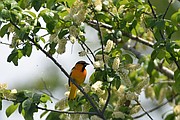Bullock’s Oriole: A fascinating, colorful bird!
Bullock’s Orioles guard their nest and may mob squirrels, crows, jays, and other predators. Females tend to sing near the nest site, while males often sing elsewhere.
— The Cornell Lab
Bullock Orioles are most common in Idaho where cottonwood and willow trees grow alongside rivers, streams, lakes and other wetlands. Also found at edges of clearings, in parks, on farms and along irrigation ditches. This male Bullock’s Oriole was spotted along the Kootenai River west of Bonners Ferry.
Male Bullock’s Orioles sport brilliant orange breasts and faces. Their topside is mainly black, including an onyx cap, eye-line and chin. They have contrasting bright white patches on their wings. Females are yellow-breasted, fading to a whitish belly. Their backs are pale brown. These muted colors help hide them and their nests from predators, and thus keep the species going.
The word “nimble” often is used to describe the Bullock’s Oriole. The Bullock’s Orioles dangle from the swaying tips of cottonwood branches where they weave the hanging baskets that will hold their eggs and nestlings.
They glean insect meals from those same precarious twigs; or from larger branches, or trunks, or from spider webs, or brush on the ground.
They are versatile, and also resourceful. If they catch a bee, they’ll pull and discard the stinger before dining. If they catch a toxic butterfly, such as a monarch or swallowtail, they’ll bang it on a branch to extract just the insides and avoid the poisons stored in the butterfly’s skin.
Bullock’s Orioles create fruit juice by piercing the skin of the fruit and opening their bills inside, then lapping the mushy liquid with their long tongues.
They can also use those tongues at hummingbird feeders, where a modest perch and a broken-out floret can invite repeat visits.
Bullock’s Orioles winter in Mexico and nest all across the western half of the U.S. They were once lumped with the eastern Baltimore oriole; but now scientists believe they are not even closely related to that species. They are members of the same family as blackbirds and meadow larks.
Besides being brilliant and nimble, these birds are fast. To see them, listen for their harsh chatter mixed with melodious squeaking, and keep an eye on tall trees.
Hopefully you will find one of their twig-end nests, a hanging basket the size of a big orange. After two weeks of incubation, both parents will tend the nestlings there, offering ready views of some of nature’s brightest beauties.
The diet for both adults and young is almost exclusively insects. However, the adults will come to a nectar feeder, using the same solution as for hummingbirds. Feeders designed specifically for orioles often include a shallow dish for grape jelly and a place to attach orange halves.
The Bullock’s oriole is one of the few songbird species in which the female also sings. Her song varies somewhat from the male’s. She will sing up to and during nest building, and may actually sing more than the male.
Enjoy Boundary County and all its wildlife.



